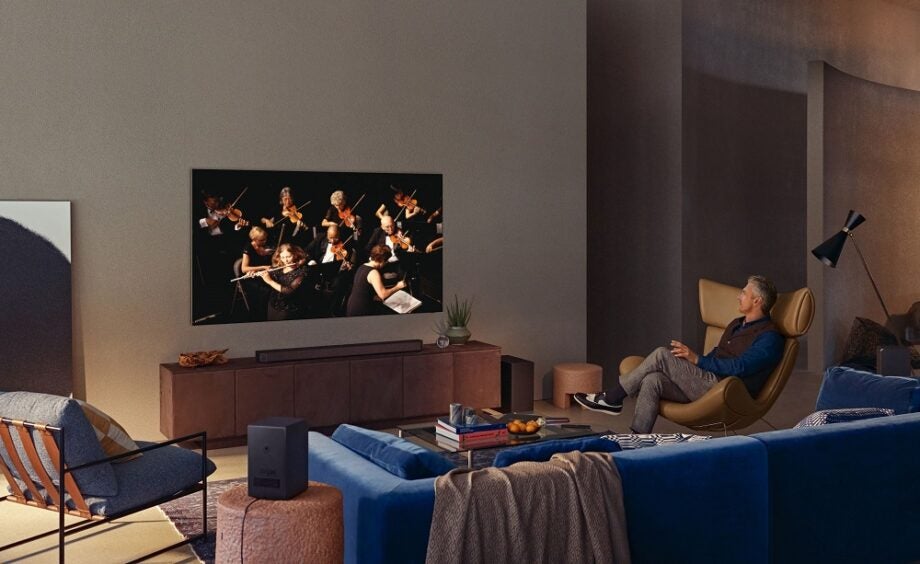Samsung’s QD-OLEDs could be coming to steal LG’s OLED thunder

Back when OLED displays were less of a known quantity, Samsung’s curved KN55S9C was its first and only attempt at an OLED TV. Suffice to say the South Korean giant went down another path that would eventually lead to its Quantum Dot QLED TVs.
Having propelled QLED into the consciousness of consumers, Samsung has traded barbs with LG over OLED in a (sometimes amusing) ‘difference of opinions’. And given LG is the pre-eminent producer of OLED displays for TVs – pretty much any brand with an OLED in its line-up buys the display from LG – and the landscape of TV tech has been condensed into a fight between Quantum Dot displays and OLED.
But why have two competing technologies doing their best impression of the unstoppable force versus the immovable object, when you could have one that melds the best of both?
That, essentially, is what QD-OLED aims to do.
A brief sidebar on what QD-OLED is – or at least what’s known about it. QD-OLED, it is surmised, would marry the black levels and contrast of OLED screens with a peak luminance (brightness) that outguns any consumer OLED currently available.
If that sounds like Mini-LED then yes, it does sound similar but likely wouldn’t need the local dimming solution of those TVs. In theory, QD-OLED could have all the benefits of QLED – its brightness, wide colour range and colour volume – cribbed with the contrast, pixel level dimming control and wide viewing angles of OLED and potentially none of the disadvantages (image retention).
Much has been written about QD-OLED since 2019, and even when Samsung Display committed $10.9bn to manufacturing displays at its dedicated Q1 production facility, Samsung Electronics – the home of its TV arm ‘Visual Display’ – were said to be lukewarm.
However, it seems Samsung Electronics is at least more receptive to the technology. Recent news out of South Korea indicates Samsung Display is on track to submit a QD-OLED hybrid prototype this summer. Referring to reports from 2020, both Panasonic and Sony are thought to be interested – two LG Display customers potentially jumping ship – with Sony said to be considering a QD-OLED gaming display. File that in the rumour mill for now.
Nevertheless, while the roadmap for QD-OLED suggests a 2022 release, no-one should be getting ahead of themselves just yet. There’s even rumours of a QNED display, so nothing is yet guaranteed.
Another mitigating factor is that Samsung Display’s prototype panel samples were apparently rejected because of their low luminance (brightness). Given the strides (some may say a rather amble walk) of OLED in this regard, there have been recent advances. Panasonic’s flagship Master OLED HDR Professional Edition panels is high in both average and peak brightness (peak is just under 1000nits); while LG’s Evo OLED panel is said to increase luminance by 20% (think of it as a better highlights and punchier HDR than a brighter overall image). None of those OLEDs are what you’d term ‘affordable’, though.
Samsung Electronics is also said to want higher yield rates, and given that reports mention the Q1 production facility is currently capable of 30,000 Gen 8.5 substrates (or panels) per month, LG Display is operating at 140,000 Gen 6.5 substrates per month. There’s a distance that needs to be travelled before QD-OLED becomes a reality.
More to the point, QD-OLED is still behind the curtains while OLED is performing on stage. 2020 saw OLED fall to its cheapest prices yet; 48-inch OLED displays hit the market, making OLED an option for smaller spaces and LG is about to get even more aggressive in the price domain, with its A1 OLED thought to reduce barriers to entry in order to drive mainstream adoption. Who’s to say how much a QD-OLED TV will cost? Considering the premium area of the market it has its eyes on, a guess is it won’t be affordable.
Where does this leave us? Likely in a state of anticipation. If Samsung goes ahead with QD-OLED and they hit the performance levels expected, then the gloves will be well and truly off in the battle for TV supremacy between the two South Korean electronic giants.


